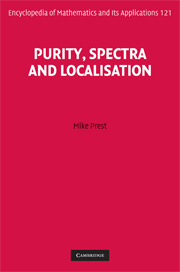Appendix E - Some definitions
Published online by Cambridge University Press: 05 March 2013
Summary
Formulas Essentially, but not literally, what we have called a condition in this book. We use the latter term since it de-emphasises the syntactic view of a formula as a string of symbols in a formal language and encourages one to focus on the solution set of such a formula and on the functor that it defines; a formula per se is merely a representative of an equivalence class, so, though useful to manipulate, is not in itself the object of interest. Formal languages are discussed in Appendices A and B.
In practice, the term “condition” is used in this book with some ambiguity: sometimes it does refer to a particular formula (in the strict syntactic sense) but, if pressed, I would formally define a condition to be a certain type of functor; then a formula is a kind of presentation of this functor. A pp-type would, therefore, literally be a set of functors: it can be represented by a set of formulas and it is often convenient to identify it with such a set of formulas.
Model theory Basic definitions have been given in Appendix A. I would not be so brave (or foolish) as to attempt a definition here; it is a rather wide-ranging subject. But I can certainly point to some arguments in the book which have a model-theoretic flavour (1.3.26, 1.3.27, 2.1.21, 2.4.5, 3.3.6, part of 3.4.24, 4.1.4, 4.2.1, 4.2.2, 4.3.11, 4.3.21, 7.3.2, for instance). For the model theory of modules per se, see Appendices A and D as well as [495].
Information
- Type
- Chapter
- Information
- Purity, Spectra and Localisation , pp. 703 - 717Publisher: Cambridge University PressPrint publication year: 2009
